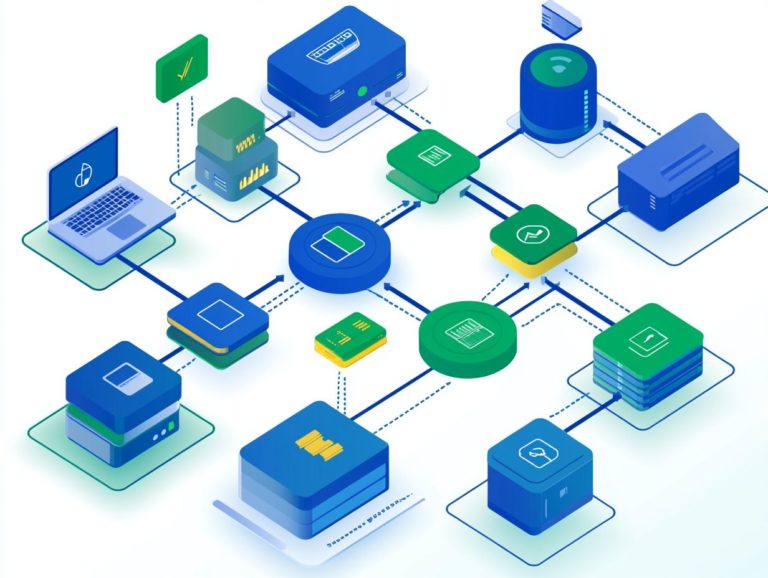Benefits of Using PaaS for Developers
In the ever-evolving landscape of technology, you find yourself navigating a realm where developers are continually on the lookout for solutions that boost productivity while keeping costs in check.
Get ready to discover ten amazing advantages of PaaS that could transform your business! PaaS is a true game-changer that offers a treasure trove of benefits tailored to meet the demands of modern development.
With PaaS, you can save both time and resources while gaining access to cutting-edge tools. This enables your team to innovate faster and more efficiently.
This article explores ten compelling advantages of PaaS, providing insights into how it operates, the leading providers, and ways your business can harness its transformative power for growth.
Explore with us how PaaS can elevate your development process to new heights.
Contents
- Key Takeaways:
- 1. Saves Time and Resources
- 2. Scalability and Flexibility
- 3. Easy Deployment and Management
- 4. Reduced Development Costs
- 5. Access to Advanced Tools and Technologies
- 6. Improved Collaboration and Communication
- 7. Increased Security and Compliance
- 8. Automatic Updates and Maintenance
- 9. Faster Time to Market
- 10. Pay-Per-Use Pricing Model
- What Is PaaS and How Does It Work?
- Frequently Asked Questions
- What is PaaS and how does it benefit developers?
- How does PaaS improve collaboration among developers?
- What are some key features of PaaS that make it beneficial for developers?
- How does PaaS help speed up the software development process?
- What are the cost benefits of using PaaS for developers?
- How does PaaS benefit developers in terms of scalability?
Key Takeaways:

PaaS saves developers time and resources by providing ready-to-use infrastructure and tools. This allows them to focus on coding and development, making it essential to understand why choose PaaS for application development.
PaaS offers scalability and flexibility, providing developers with the ability to easily adjust resources based on their needs. For more insights, check out the benefits of PaaS for remote teams.
PaaS streamlines deployment and management processes, making it easier for developers to launch and manage applications without additional IT support, especially in sectors like healthcare, where understanding the benefits of PaaS for healthcare applications can be crucial.
1. Saves Time and Resources
In the realm of cloud computing, understanding PaaS: key features and benefits can significantly enhance your efficiency by saving both time and resources. This is an essential advantage for businesses aiming to streamline their software development processes.
By leveraging middleware software that connects different applications you can optimize operational savings while minimizing reliance on server resources. This ultimately frees you to focus on innovation rather than getting bogged down with infrastructure management.
PaaS solutions automate various aspects of development through built-in tools and pre-configured environments. This drastically reduces the time needed to launch applications.
Take platforms like Oracle Cloud Platform, for example. They offer robust resource management capabilities that allow you to easily scale applications based on demand. This functionality not only cuts operational costs but also increases your project’s agility.
Automated testing and deployment tools reduce manual effort, ensuring faster iterations and timely updates. This enhances your productivity and facilitates a more cost-effective development lifecycle.
2. Scalability and Flexibility
Scalability and flexibility are two of the most significant advantages of using PaaS. These features allow you to scale your applications effortlessly in response to evolving demands on cloud platforms like AWS, Google Cloud, and Microsoft Azure.
This capability revolutionizes your approach to application development, enabling you to allocate resources dynamically based on real-time traffic and user needs.
For example, if you run an e-commerce business, you can seamlessly increase your computing power during peak shopping seasons. This improves user experience and protects you from potential revenue losses.
Similarly, as a fintech startup, you can leverage PaaS to quickly adapt your services in response to regulatory changes, keeping you one step ahead of the competition. This adaptability empowers you to innovate rapidly, ensuring you remain responsive to market trends and customer requirements.
3. Easy Deployment and Management
The ease of deployment and management provided by PaaS and the future of software development solutions significantly simplifies your application development process. It cuts down on the complexities typical of traditional software deployment.
By leveraging the centralized management tools offered by cloud service providers, you can enjoy a seamless experience that features automated scaling, integrated security options, and built-in continuous integration and delivery (CI/CD) pipelines.
These capabilities save you valuable time and reduce the chances of errors during deployment. With real-time monitoring of application performance, you can swiftly tackle any issues and optimize your Java applications or enterprise software.
In the end, these enhanced features empower your team to concentrate on innovation rather than getting mired in infrastructure concerns.
Ready to explore how PaaS can benefit your business? Discover the various options available and take your development process to the next level!
4. Reduced Development Costs
One of the most enticing aspects of Platform as a Service (PaaS) is its potential to significantly reduce development costs. This positions it as an appealing choice for organizations eager to streamline their software development lifecycle.
By reducing the need for extensive hardware infrastructure and specialized personnel, PaaS allows you to focus your resources on innovation and efficiency. A study by Frost & Sullivan revealed that businesses implementing PaaS solutions experienced an average reduction of 25% in infrastructure costs. They also accelerated their time-to-market by as much as 30%.
Take Dropbox, for example. They have effectively harnessed PaaS to enhance scalability without the burdensome expenses typically associated with traditional software development. This proves that these platforms can save you a lot of money!
5. Access to Advanced Tools and Technologies
PaaS platforms grant you access to a powerful suite of advanced tools and technologies, from AI analytics to sophisticated cloud management systems. All are designed to elevate your application development process.
These offerings significantly enhance your overall efficiency. This allows you to direct your energy toward innovation instead of becoming bogged down by infrastructure.
NoSQL databases are great for handling different types of data, while traditional relational databases work best for structured data like tables.
Tools tailored for integrating artificial intelligence and machine learning streamline your workflows by automating complex tasks. This ultimately reduces your time-to-market. You can leverage emerging technologies seamlessly, fostering a culture of creativity and rapid iteration within your business.
6. Improved Collaboration and Communication

The collaborative nature of Platform as a Service (PaaS) significantly enhances communication among your development teams. This is essential for executing projects successfully and aligning with your business objectives.
You can easily communicate through the platform. This allows you to share updates, resolve issues, and brainstorm ideas in real time.
The shared environments facilitate seamless collaboration, letting all team members access the same resources, documents, and tools concurrently.
This connection boosts team morale and minimizes project delays often caused by miscommunication or information silos. As a result, these features create a more streamlined workflow, boosting overall efficiency and ensuring that your project outcomes are timely and in sync with your strategic goals.
7. Increased Security and Compliance
In the realm of cloud computing, prioritizing increased security and compliance is essential. PaaS solutions provide you with robust measures to protect sensitive data while ensuring adherence to industry regulations.
These platforms deploy stringent security protocols, including multifactor authentication and continuous monitoring. This effectively mitigates the risks posed by cyber threats. Integrated encryption mechanisms secure your data both in transit and at rest, shielding it from unauthorized access.
Compliance frameworks such as GDPR and HIPAA enable you to operate within legal boundaries, delivering valuable peace of mind. You must prioritize these security measures to avoid costly breaches, eroding customer trust and resulting in legal repercussions that could impact even the most established enterprises.
8. Automatic Updates and Maintenance
Automatic updates and maintenance are standout benefits of using PaaS. They significantly lighten the operational load on your development teams and ensure your applications stay up-to-date with the latest features and security patches. To learn more about these advantages, check out the business case for adopting PaaS.
These built-in maintenance capabilities not only minimize downtime but also elevate overall productivity. This allows your teams to channel their energy into innovative solutions rather than getting bogged down by routine upkeep.
Platforms like Google App Engine and Microsoft Azure automatically handle infrastructure updates. This enables you to deploy new functionalities quickly and securely.
This seamless update process guarantees that you always have access to the latest tools and resources, giving you the power to operate more efficiently while mitigating the risks associated with outdated software vulnerabilities.
9. Faster Time to Market
By leveraging PaaS, you can achieve a faster time to market for your applications an essential advantage in today s competitive landscape where responsiveness is vital for success.
This platform offers a range of innovative features that streamline your development process. Pre-configured environments eliminate the need for extensive setup time, allowing you to concentrate on building features rather than wrestling with configuration.
The availability of templates accelerates your project initiation by offering reusable components designed for common functionalities. Meanwhile, workflow automation reduces the manual tasks associated with development and deployment, significantly boosting your productivity.
Consider case studies, such as that of a prominent retail chain, which illustrate how these features enabled them to launch a new mobile application in just weeks instead of the typical months. This provided them with a valuable competitive edge in the market.
10. Pay-Per-Use Pricing Model
The pay-per-use pricing model of PaaS presents you with remarkable flexibility and cost-saving opportunities. It allows you to pay only for the resources you actively consume throughout your cloud computing journey.
This innovative approach sharply contrasts with traditional licensing models, where businesses often find themselves locked into long-term contracts and upfront payments that may not reflect their actual usage needs.
By embracing a pay-as-you-go model, you give your organization the power to scale operations seamlessly, effortlessly adapting to fluctuating demands without the burden of unnecessary costs.
Top PaaS providers like Google Cloud, Amazon Web Services, and Microsoft Azure offer competitive pay-per-use options. This enables you to tailor your resource use according to your needs based on real performance metrics. This strategy not only leads to significant savings but also empowers your business to adapt quickly while enhancing overall business agility.
What Is PaaS and How Does It Work?
Platform-as-a-Service (PaaS) is your go-to cloud computing model that gives you the power to develop, run, and manage applications without the usual headaches of building and maintaining the underlying infrastructure associated with software development.
This model effortlessly streamlines your application development process by offering a rich array of tools and services designed to enhance your workflows. With integrated platform services at your disposal, you can concentrate on writing code instead of getting bogged down with server or storage management.
Middleware (software that connects different applications and services) becomes your ally here, delivering essential features like data integration, messaging services, and authentication solutions. This ensures that all components of your application work in perfect harmony.
Cloud service providers equip you with these capabilities, allowing your business to scale applications swiftly and efficiently while keeping operational costs in check.
How Does PaaS Compare to Other Cloud Computing Models?

When comparing Platform-as-a-Service (PaaS) with other cloud computing models like Software-as-a-Service (SaaS) and Infrastructure-as-a-Service (IaaS), each model offers unique advantages tailored to various business needs.
IaaS provides essential computing resources such as virtual machines and storage. This flexibility is critical for companies requiring control over their infrastructure.
SaaS, on the other hand, gives you seamless access to software applications without installation hassles. This makes it a great choice for businesses looking for quick deployment of tools like customer relationship management systems.
PaaS truly makes development easier. It offers pre-configured application frameworks, allowing you to focus on coding instead of managing underlying infrastructure, providing numerous key advantages for enterprises.
Understanding these distinctions empowers you to make informed choices about which model aligns best with your operational strategies and long-term objectives.
What Are the Top PaaS Providers in the Market?
The market is filled with numerous PaaS providers, with heavyweights like Amazon Web Services, Google Cloud, Microsoft Azure, and Oracle Cloud Platform leading the way.
Each platform comes with unique features designed to meet various enterprise needs, whether it s scalability, integration capabilities, or development tools.
For example, Amazon Web Services excels with its extensive range of services and pay-as-you-go pricing model ideal for businesses seeking flexibility and growth.
Google Cloud stands out with advanced analytics and machine learning capabilities, making it a top choice for enterprises focused on innovative data solutions.
Microsoft Azure integrates smoothly with existing enterprise software, offering a significant advantage for organizations invested in Microsoft tools.
Meanwhile, Oracle Cloud Platform boasts robust database management features, appealing to enterprises that demand sophisticated data handling.
By evaluating these distinct characteristics, you empower your organization to select the optimal PaaS provider that aligns with your specific application requirements.
How Can Developers Benefit from Using PaaS?
You can unlock a wealth of advantages by embracing PaaS solutions! These include heightened productivity, quicker time to market, and enhanced collaboration throughout the software development lifecycle.
PaaS platforms provide robust access to essential development tools, enabling your team to leverage pre-built components and APIs that dramatically accelerate the creation process.
For instance, a leading e-commerce company revamped its checkout process in weeks instead of months by taking advantage of integrated cloud services.
PaaS solutions often facilitate streamlined workflows that align with DevOps practices, empowering you to achieve continuous integration and delivery.
This allows you to test and deploy code at lightning speed like a tech startup rolling out new features daily, boosting competitiveness in an ever-evolving market!
What Are the Potential Challenges of Using PaaS?
While PaaS offers many advantages, it s crucial to be mindful of potential challenges such as vendor lock-in, security issues, and limited control over underlying infrastructure.
You may face obstacles like compliance concerns and data migration complexities, which could limit your flexibility.
Navigating these challenges requires strategic planning and thorough assessments to ensure a smooth journey.
To tackle compliance issues, verify your chosen PaaS provider s adherence to relevant regulations and data protection standards.
Crafting a robust data migration strategy, complete with thorough backup procedures, will streamline the transition process and minimize disruptions.
Embracing a multi-cloud strategy can further reduce dependency on a single provider, enhancing your overall resilience and adaptability to evolving business needs.
How Can Businesses Leverage PaaS for Their Development Needs?
You can leverage PaaS (Platform as a Service) to effectively address your application development needs. This unlocks operational savings and allows you to focus more sharply on your core business strategies.
By adopting strategic approaches that align your development efforts with overarching business goals, you can ensure that your resources are utilized in the most efficient manner.
Striking the right balance is crucial! As your teams navigate the PaaS landscape, it’s essential to allocate talent and infrastructure wisely.
Integrating advanced tools and technologies will streamline your processes, enhance collaboration, and foster innovation. Ultimately, this drives more successful outcomes.
This thoughtful alignment boosts productivity and gives your teams the power to respond swiftly to market demands, positioning your organization to capitalize on emerging opportunities.
Frequently Asked Questions
What is PaaS and how does it benefit developers?

PaaS, or Platform as a Service, is a cloud computing model that provides developers with a platform to develop, test, deploy, and manage applications without needing to build or maintain the underlying infrastructure. This allows developers to focus on writing code, speeding up the development process and making it more efficient and cost-effective.
How does PaaS improve collaboration among developers?
PaaS offers a centralized platform for developers to work together on the same project. This makes collaboration seamless and efficient, as all team members have access to the same tools and resources. PaaS also supports real-time updates and version control, making it easier for teams to work together and avoid conflicts.
What are some key features of PaaS that make it beneficial for developers?
PaaS offers many features that make it attractive to developers, including automated deployment, scalability, and built-in security. It also provides access to a wide range of programming languages, frameworks, and tools, enhancing software development by giving developers the flexibility to choose the best options for their project. For more insights, check out how PaaS enhances software development.
How does PaaS help speed up the software development process?
PaaS provides a ready-to-use platform and eliminates the need to set up and maintain infrastructure, allowing developers to focus solely on writing code. This speeds up the development process, enabling developers to quickly create and deploy applications without worrying about the underlying infrastructure.
What are the cost benefits of using PaaS for developers?
PaaS offers a pay-as-you-go model, meaning developers only pay for the resources they use. This eliminates upfront infrastructure costs and allows for easy scalability. PaaS also cuts down on the time and resources needed for maintenance, further reducing overall costs for developers.
How does PaaS benefit developers in terms of scalability?
PaaS offers automatic scaling based on demand, meaning resources can be easily increased or decreased as needed. This allows developers to quickly respond to changes in traffic or user demand, ensuring that their applications remain performant and accessible to users.
Ready to take your development to the next level with PaaS? Start exploring today!





